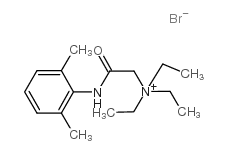Lidocaine N-ethyl bromid

Lidocaine N-ethyl bromid structure
|
Common Name | Lidocaine N-ethyl bromid | ||
|---|---|---|---|---|
| CAS Number | 21306-56-9 | Molecular Weight | 343.30200 | |
| Density | N/A | Boiling Point | N/A | |
| Molecular Formula | C16H27BrN2O | Melting Point | N/A | |
| MSDS | Chinese USA | Flash Point | N/A | |
|
Local anesthetic inhibition of a bacterial sodium channel.
J. Gen. Physiol. 139(6) , 507-16, (2012) Recent structural breakthroughs with the voltage-gated sodium channel from Arcobacter butzleri suggest that such bacterial channels may provide a structural platform to advance the understanding of eukaryotic sodium channel gating and pharmacology. We therefo... |
|
|
Membrane permeable local anesthetics modulate Na(V)1.5 mechanosensitivity.
Channels (Austin.) 6(4) , 308-16, (2012) Voltage-gated sodium selective ion channel Na(V)1.5 is expressed in the heart and the gastrointestinal tract, which are mechanically active organs. Na(V)1.5 is mechanosensitive at stimuli that gate other mechanosensitive ion channels. Local anesthetic and ant... |
|
|
Overinhibition of corticostriatal activity following prenatal cocaine exposure.
Ann. Neurol. 73(3) , 355-69, (2013) Prenatal cocaine exposure (PCE) can cause persistent neuropsychological and motor abnormalities in affected children, but the physiological consequences of PCE remain unclear. Conclusions drawn from clinical studies can sometimes be confounded by polysubstanc... |
|
|
Emulsified isoflurane enhances thermal transient receptor potential vanilloid-1 channel activation-mediated sensory/nociceptive blockade by QX-314.
Anesthesiology 121(2) , 280-9, (2014) QX-314 produces nociceptive blockade, facilitated by permeation through transient receptor potential vanilloid-1 (TRPV1) channels. TRPV1 channel can be activated by noxious heat and sensitized by volatile anesthetics. The authors hypothesized that emulsified ... |
|
|
Use of escin as a perforating agent on the IonWorks quattro automated electrophysiology platform.
J. Biomol. Screen. 18(1) , 128-34, (2013) The automated electrophysiology platform IonWorks has facilitated the medium-throughput study of ion channel biology and pharmacology. Electrical and chemical access to the cell is by perforated patch, afforded by amphotericin. Permeation of the amphotericin ... |
|
|
Activation of TRPA1 by membrane permeable local anesthetics.
Mol. Pain 7 , 62, (2011) Low concentrations of local anesthetics (LAs) suppress cellular excitability by inhibiting voltage-gated Na⁺ channels. In contrast, LAs at high concentrations can be excitatory and neurotoxic. We recently demonstrated that LA-evoked activation of sensory neur... |
|
|
The balance of striatal feedback transmission is disrupted in a model of parkinsonism.
J. Neurosci. 33(11) , 4964-75, (2013) Inhibitory connections among striatal projection neurons (SPNs) called "feedback inhibition," have been proposed to endow the striatal microcircuit with computational capabilities, such as motor sequence selection, filtering, and the emergence of alternating ... |
|
|
Permeation and block of TRPV1 channels by the cationic lidocaine derivative QX-314.
J. Neurophysiol. 109(7) , 1704-12, (2013) QX-314 (N-ethyl-lidocaine) is a cationic lidocaine derivative that blocks voltage-dependent sodium channels when applied internally to axons or neuronal cell bodies. Coapplication of external QX-314 with the transient receptor potential vanilloid 1 protein (T... |
|
|
Nociceptor-selective peripheral nerve block induces delayed mechanical hypersensitivity and neurotoxicity in rats.
Anesthesiology 120(4) , 976-86, (2014) Long-lasting, sensory-specific peripheral nerve blockade would advance perioperative analgesia. Perineural injection of a combination of transient receptor potential vanilloid 1 channel agonists and lidocaine or its hydrophilic derivative, QX-314, produces pr... |
|
|
Acid solution is a suitable medium for introducing QX-314 into nociceptors through TRPV1 channels to produce sensory-specific analgesic effects.
PLoS ONE 6(12) , e29395, (2011) Previous studies have demonstrated that QX-314, an intracellular sodium channel blocker, can enter into nociceptors through capsaicin-activated TRPV1 or permeation of the membrane by chemical enhancers to produce a sensory-selective blockade. However, the obv... |